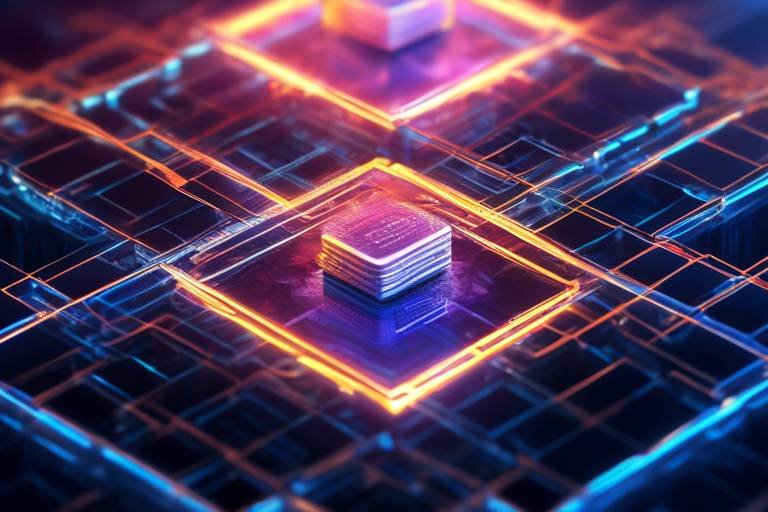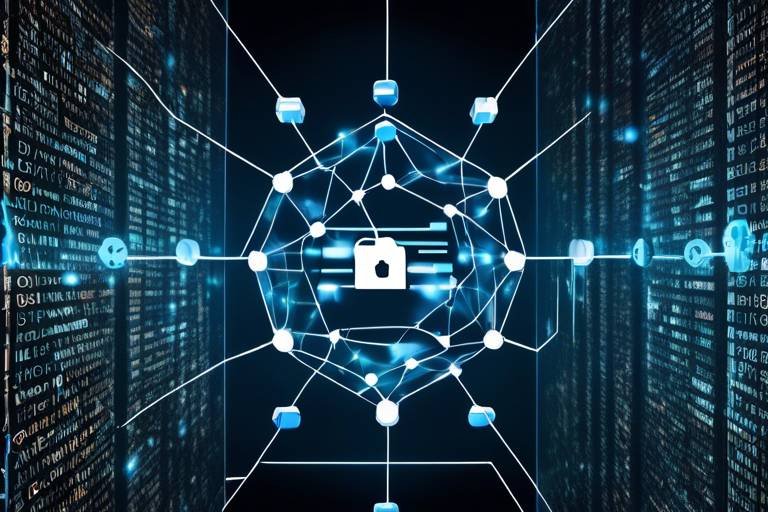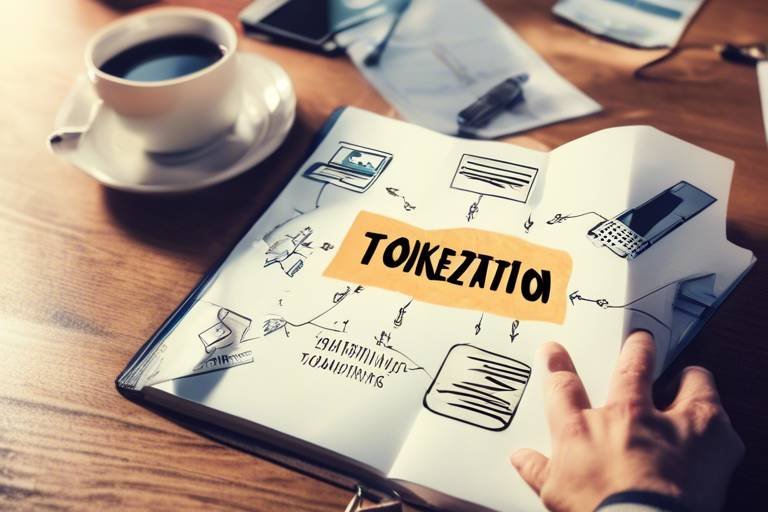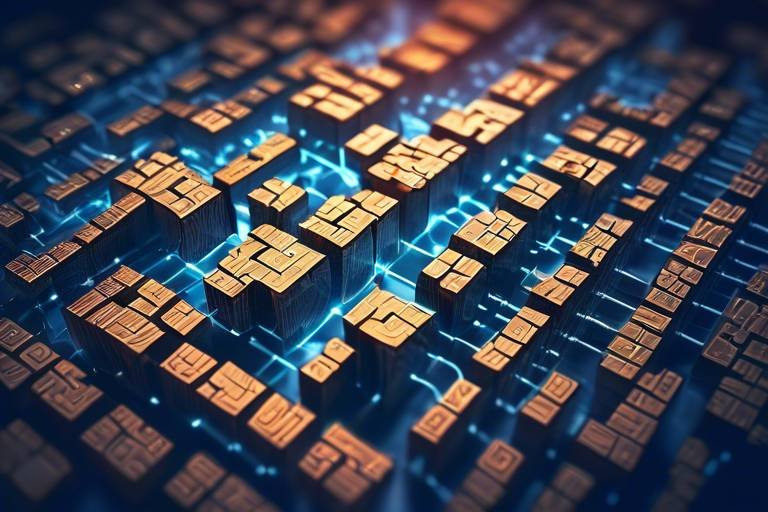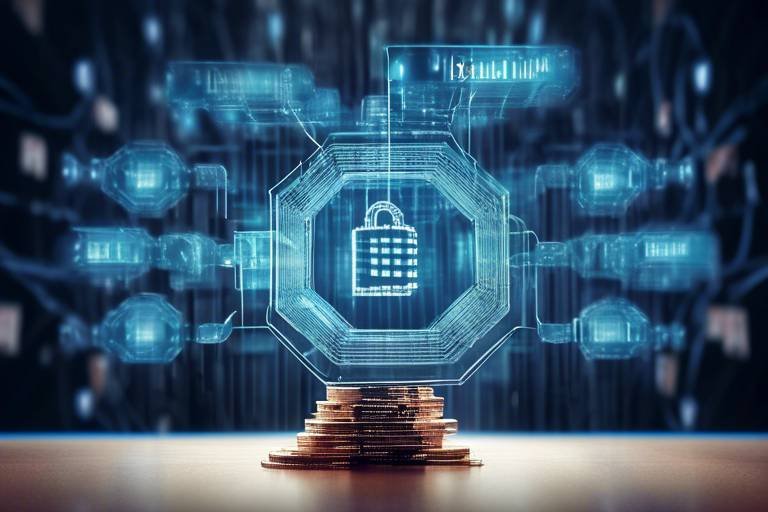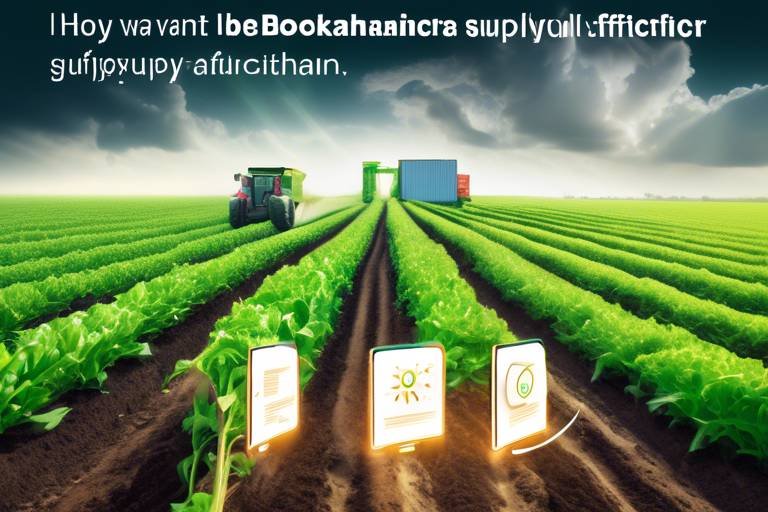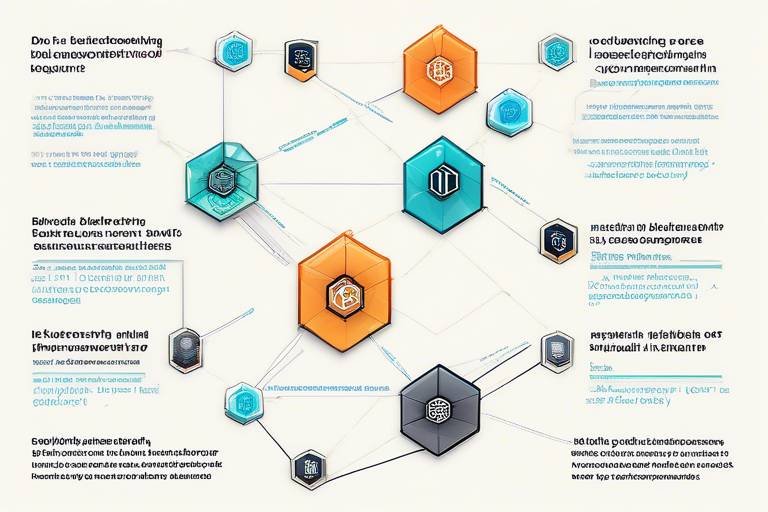Understanding Layer 2 Solutions - Enhancing Blockchain Scalability
In the ever-evolving world of blockchain technology, the quest for **scalability** has become a pressing concern. As more users flock to decentralized networks, the limitations of Layer 1 solutions—such as Bitcoin and Ethereum—become glaringly apparent. Transactions can slow to a crawl, fees skyrocket, and the user experience suffers. Enter **Layer 2 solutions**, the superheroes of the blockchain universe! These innovative protocols are designed to operate atop existing blockchains, offering a way to enhance scalability and efficiency without the need for drastic changes to the underlying structure. Imagine a bustling highway where traffic is so heavy that cars barely move. Layer 2 solutions act like express lanes, allowing for smoother and faster travel, ensuring that the blockchain can handle a surge in users without breaking a sweat.
Layer 2 solutions come in various forms, from payment channels to sidechains, each tailored to meet specific challenges. They facilitate faster transactions, lower fees, and ultimately provide a better user experience. By processing transactions off the main blockchain, these solutions help to alleviate congestion, making it possible for users to enjoy the benefits of blockchain technology without the usual frustrations. Think of them as a **traffic management system** that optimizes flow, ensuring everyone reaches their destination quickly and efficiently. As we dive deeper into the world of Layer 2 solutions, we'll uncover the myriad benefits they offer, the challenges they face, and their potential to revolutionize the blockchain landscape.
Layer 2 solutions refer to protocols built on top of existing blockchains that enhance scalability and transaction speed without altering the underlying blockchain's protocol, offering innovative ways to manage transactions effectively.
Layer 2 solutions provide numerous advantages, including reduced transaction fees, increased throughput, and enhanced user experience, making them essential for the future of blockchain technology and its widespread adoption.
By processing transactions off the main blockchain, Layer 2 solutions can significantly reduce congestion and latency, allowing for faster transaction confirmations and a smoother user experience in various applications.
Several Layer 2 solutions, such as the Lightning Network and Optimistic Rollups, showcase remarkable transaction speeds, demonstrating their potential to revolutionize how users interact with blockchain technology.
Layer 2 solutions are being implemented in various sectors, including finance, gaming, and supply chain management, showcasing their versatility and effectiveness in addressing real-world scalability challenges.
Layer 2 solutions can drastically lower transaction fees by optimizing how transactions are processed, making blockchain technology more accessible for everyday users and businesses alike.
Several prominent Layer 2 solutions have emerged in the blockchain space, each offering unique features and benefits tailored to different use cases and industries, contributing to the overall growth of blockchain technology.
The Lightning Network is a prominent Layer 2 solution for Bitcoin, enabling instant transactions and significantly lower fees, making it a vital component for scaling Bitcoin's usability for everyday transactions.
Polygon is a multi-chain Layer 2 scaling solution for Ethereum that enhances transaction speed and reduces costs, providing developers with tools to build and connect Ethereum-compatible blockchain networks efficiently.
Despite their advantages, Layer 2 solutions face challenges, including security concerns, interoperability issues, and user adoption hurdles, which must be addressed for their successful implementation and long-term viability.
Layer 2 solutions must ensure robust security measures to protect users' assets, as vulnerabilities can arise from the complexity of off-chain transactions and interactions with the main blockchain.
Achieving seamless interoperability between different Layer 2 solutions and Layer 1 blockchains remains a challenge, necessitating the development of standards and protocols to facilitate cross-chain communication.
As blockchain technology continues to evolve, Layer 2 solutions are expected to play a pivotal role in enhancing scalability, fostering innovation, and driving mainstream adoption across various industries and applications.
- What are the key benefits of Layer 2 solutions? Layer 2 solutions offer improved transaction speeds, reduced fees, and enhanced scalability, making blockchain technology more accessible and user-friendly.
- How do Layer 2 solutions work? They operate on top of existing blockchains, processing transactions off-chain to alleviate congestion and improve efficiency.
- What are some popular Layer 2 solutions? Notable examples include the Lightning Network for Bitcoin and Polygon for Ethereum.
- Are there any challenges associated with Layer 2 solutions? Yes, challenges include security concerns, interoperability issues, and user adoption hurdles.

What are Layer 2 Solutions?
Layer 2 solutions are innovative protocols designed to operate on top of existing blockchains, effectively enhancing their scalability and transaction speeds without modifying the core underlying blockchain protocol. Think of it as adding an express lane to a busy highway: while the main road (Layer 1) remains unchanged, the express lane allows for faster travel, reducing congestion and improving overall traffic flow.
These solutions serve as a bridge between the user and the blockchain, enabling more efficient transaction management. By processing transactions off the main chain, Layer 2 solutions can alleviate the burden on Layer 1, which often struggles with high demand and limited throughput. This is particularly crucial in the world of cryptocurrencies, where transaction speed and cost can significantly impact user experience and adoption.
To better understand Layer 2 solutions, let’s explore their key components and how they function:
- Off-Chain Processing: Layer 2 solutions handle transactions outside the main blockchain, allowing for quicker confirmations and reduced load on the base layer.
- State Channels: This method allows two parties to conduct transactions privately and only settle the final result on the main blockchain, minimizing the number of on-chain transactions.
- Rollups: These solutions bundle multiple transactions into a single one, reducing the data that needs to be processed on the main chain, thereby saving space and increasing speed.
Overall, Layer 2 solutions are essential for the evolution of blockchain technology, addressing the limitations of Layer 1 systems and paving the way for broader adoption. They not only improve transaction efficiency but also lower costs, making blockchain technology more accessible to a wider audience. As the demand for blockchain applications grows, the significance of these solutions will only increase, making them a vital part of the future landscape of digital transactions.

Benefits of Layer 2 Solutions
Layer 2 solutions are revolutionizing the blockchain landscape by addressing some of the most pressing challenges faced by traditional Layer 1 blockchains. These solutions act as a bridge, enhancing the overall performance and usability of blockchain networks without compromising the security and integrity of the underlying protocols. Let's dive into the myriad benefits these solutions offer.
One of the most significant advantages of Layer 2 solutions is the improved transaction speed. By processing transactions off the main blockchain, these solutions alleviate congestion and drastically reduce latency. Imagine a congested highway during rush hour; Layer 2 solutions are like adding extra lanes, allowing for smoother traffic flow. This means that users can enjoy faster transaction confirmations, resulting in a more seamless experience across various applications, from decentralized finance (DeFi) to gaming.
Moreover, cost efficiency is another compelling benefit. Layer 2 solutions optimize transaction processes, which leads to significantly lower fees. This is particularly important for everyday users and small businesses that may find high transaction costs prohibitive. By reducing these fees, Layer 2 solutions make blockchain technology more accessible, encouraging broader adoption and use. For instance, a transaction that might typically cost several dollars on the main chain could be reduced to mere cents on a Layer 2 network, making microtransactions feasible.
In addition to speed and cost, Layer 2 solutions also enhance the overall user experience. With reduced fees and faster transaction times, users are more likely to engage with blockchain applications regularly. This improved experience can lead to increased user retention and satisfaction. Furthermore, the flexibility of Layer 2 solutions allows developers to create tailored experiences for different use cases, further enriching the ecosystem. For example, gaming platforms can leverage these solutions to provide instant in-game transactions without the lag typically associated with on-chain processes.
Let's take a look at the benefits in a more structured format:
| Benefit | Description |
|---|---|
| Improved Transaction Speed | Reduces congestion and latency, allowing for faster confirmations. |
| Cost Efficiency | Drastically lowers transaction fees, making blockchain more accessible. |
| Enhanced User Experience | Encourages regular engagement with blockchain applications. |
Lastly, the versatility of Layer 2 solutions cannot be overlooked. They are being implemented across various sectors, including finance, gaming, and supply chain management. Each sector benefits from the unique features of Layer 2 solutions, addressing specific scalability challenges while enhancing efficiency. For instance, in finance, these solutions can facilitate rapid transactions for high-frequency trading, while in gaming, they enable instant in-game purchases without the hassle of waiting for confirmations.
In summary, the benefits of Layer 2 solutions are profound and multifaceted. They not only improve transaction speed and reduce costs but also enhance the overall user experience and versatility of blockchain applications. As we continue to explore the potential of blockchain technology, Layer 2 solutions will undoubtedly play a crucial role in its evolution and widespread adoption.
- What are Layer 2 solutions? Layer 2 solutions are protocols built on top of existing blockchains to improve scalability and transaction speed.
- How do Layer 2 solutions reduce transaction fees? They optimize the way transactions are processed, allowing for lower costs compared to Layer 1 transactions.
- Can Layer 2 solutions enhance security? While they offer many benefits, ensuring robust security measures is crucial to protect user assets.

Improved Transaction Speed
When it comes to blockchain technology, speed is of the essence. Imagine trying to send money to a friend, but you're stuck waiting for what feels like an eternity for that transaction to confirm. Frustrating, right? This is where Layer 2 solutions come into play, revolutionizing the way we think about transaction speed. By processing transactions off the main blockchain, these solutions can significantly reduce congestion and latency, ensuring that transactions are confirmed almost instantaneously.
Layer 2 solutions act like a fast lane on a busy highway. While the main blockchain can get bogged down with traffic, these solutions allow for a smoother flow of transactions, freeing up space and enabling quicker confirmations. For example, instead of every transaction needing to be recorded on the main blockchain, Layer 2 solutions bundle multiple transactions together, which can then be processed in one go. This not only speeds up the process but also makes it more efficient.
To illustrate this point further, consider the following comparison:
| Aspect | Layer 1 Transactions | Layer 2 Transactions |
|---|---|---|
| Transaction Speed | Minutes to Hours | Seconds to Minutes |
| Cost per Transaction | High | Low |
| Network Congestion | High | Low |
As you can see from the table, the differences are stark. Layer 2 solutions not only enhance transaction speed but also reduce costs and alleviate network congestion. This is particularly important for applications that require quick confirmations, such as online gaming, micropayments, and point-of-sale transactions.
Moreover, the implementation of Layer 2 solutions has shown remarkable success in various real-world applications. For instance, the Lightning Network for Bitcoin allows users to make instant transactions with minimal fees. This has opened up new possibilities for everyday transactions, making cryptocurrencies more practical for daily use.
In summary, improved transaction speed is one of the most significant benefits of Layer 2 solutions. By alleviating the burdens of the main blockchain, these solutions not only make transactions faster but also pave the way for broader adoption of blockchain technology. As we continue to explore and innovate within this space, the potential for faster, more efficient transactions is limitless.
- What are Layer 2 solutions? - They are protocols built on top of existing blockchains to enhance scalability and transaction speed.
- How do Layer 2 solutions improve transaction speed? - By processing transactions off the main blockchain, reducing congestion and latency.
- Are Layer 2 solutions secure? - While they offer many benefits, security concerns must be addressed to protect users' assets.
- Can Layer 2 solutions be used in different industries? - Yes, they are being implemented in finance, gaming, supply chain management, and more.

Examples of Fast Transactions
When it comes to demonstrating the prowess of Layer 2 solutions, the Lightning Network and Optimistic Rollups stand out as prime examples. These innovative protocols have taken the blockchain world by storm, showcasing how transactions can be processed at lightning speed, quite literally! Imagine sending a payment across the globe in the blink of an eye; that’s the magic these technologies bring to the table.
The Lightning Network, primarily designed for Bitcoin, allows users to conduct transactions off the main blockchain. This means that instead of waiting for confirmations on the Bitcoin blockchain, which can take several minutes or even longer during peak times, users can transact almost instantly. With the Lightning Network, transactions can be completed in seconds, with fees that are a fraction of a cent. It’s like having a VIP pass to the blockchain party—no waiting in line, just quick access!
Similarly, Optimistic Rollups work by bundling multiple transactions into a single batch, which is then submitted to the main blockchain. This process not only speeds up transaction times but also significantly reduces costs. For instance, imagine you’re at a grocery store and instead of paying for each item separately, you pay for your entire cart at once. This is essentially what Optimistic Rollups do, allowing multiple transactions to be processed together, enhancing efficiency and speed.
To put this into perspective, let’s look at a comparison table showing the transaction speeds of traditional blockchain versus Layer 2 solutions like Lightning Network and Optimistic Rollups:
| Transaction Method | Average Confirmation Time | Transaction Fee |
|---|---|---|
| Bitcoin (Layer 1) | 10 minutes | $2-$5 |
| Lightning Network | Seconds | $0.01 or less |
| Optimistic Rollups | Seconds | $0.05 or less |
As you can see from the table, the difference in transaction speed and cost is staggering. With these Layer 2 solutions, the dream of a fast, efficient, and cost-effective blockchain experience is becoming a reality. Whether you’re a gamer looking to make microtransactions or a business needing to process payments quickly, these technologies are paving the way for a more scalable future.
In conclusion, as we continue to explore the capabilities of Layer 2 solutions, it’s clear that they hold the key to unlocking a new era of blockchain technology. The speed and efficiency they offer not only enhance user experience but also open doors for broader adoption across various industries. So, the next time you hear about the Lightning Network or Optimistic Rollups, remember—they’re not just buzzwords; they’re the future of fast transactions!
- What are Layer 2 solutions? Layer 2 solutions are protocols built on top of existing blockchains to enhance scalability and transaction speed without altering the underlying blockchain's protocol.
- How do Layer 2 solutions improve transaction speed? They process transactions off the main blockchain, reducing congestion and allowing for quicker confirmations.
- What are some popular Layer 2 solutions? Notable examples include the Lightning Network for Bitcoin and Polygon for Ethereum.
- What challenges do Layer 2 solutions face? Security concerns, interoperability issues, and user adoption hurdles are some of the challenges that need addressing.

Real-World Applications
Layer 2 solutions are not just theoretical constructs; they are making a tangible impact across various sectors. Imagine a world where transactions are swift, costs are low, and accessibility is high. That's the reality Layer 2 solutions are creating! Let's dive into some of the most exciting real-world applications:
In the finance sector, Layer 2 solutions are transforming how we think about payments. Traditional banking systems can be slow and cumbersome, but with solutions like the Lightning Network, Bitcoin transactions can be processed almost instantly. This speed not only enhances user experience but also opens up new avenues for microtransactions, enabling businesses to charge small fees without the burden of high transaction costs.
Moving onto the gaming industry, developers are leveraging Layer 2 tech to create immersive experiences that require fast and cost-effective transactions. For instance, games built on Ethereum can utilize solutions like Polygon to allow players to trade in-game assets seamlessly. This not only enriches the gaming experience but also empowers players to truly own their digital assets, which can be traded or sold in secondary markets.
Moreover, the supply chain management sector is witnessing a revolution thanks to Layer 2 solutions. By enabling real-time tracking of goods with reduced costs and increased speed, companies can ensure transparency and efficiency in their operations. For example, using Layer 2 protocols, businesses can quickly verify the authenticity of products, track shipments, and manage inventories with unprecedented ease. This not only reduces fraud but also enhances consumer trust.
Here’s a quick look at how Layer 2 solutions are being applied across different sectors:
| Sector | Application | Benefits |
|---|---|---|
| Finance | Instant Bitcoin transactions | Faster payments, lower fees |
| Gaming | In-game asset trading | Player ownership, seamless transactions |
| Supply Chain | Real-time tracking | Transparency, reduced fraud |
These examples illustrate just a fraction of the potential that Layer 2 solutions hold. As more industries begin to adopt these technologies, we can expect to see even more innovative applications emerge. The future is bright, and Layer 2 solutions are at the forefront of this transformation, making blockchain technology more accessible and efficient for everyone.
- What are Layer 2 solutions? Layer 2 solutions are protocols built on top of existing blockchains to enhance scalability and transaction speed without altering the underlying blockchain protocol.
- How do Layer 2 solutions improve transaction speed? By processing transactions off the main blockchain, they reduce congestion and latency, allowing for faster confirmations.
- What are some popular Layer 2 solutions? Notable examples include the Lightning Network for Bitcoin and Polygon for Ethereum.
- What challenges do Layer 2 solutions face? They encounter security concerns, interoperability issues, and user adoption hurdles that need to be addressed.
- What is the future of Layer 2 solutions? They are expected to play a pivotal role in enhancing scalability and driving mainstream adoption across various industries.

Cost Efficiency
When it comes to blockchain technology, one of the most significant barriers to widespread adoption has been the cost of transactions. Traditional Layer 1 solutions often impose hefty fees, especially during peak times when the network is congested. This is where Layer 2 solutions come into play, acting as a breath of fresh air by drastically lowering these costs. By processing transactions off the main blockchain, they optimize how data is handled, which in turn leads to a more cost-effective solution for users and businesses alike.
Imagine going to a concert where tickets are sold at an inflated price due to high demand. Now, what if there was a way to enjoy the same concert experience at a fraction of the price? This analogy perfectly illustrates how Layer 2 solutions work—they provide a more affordable means of engaging with blockchain technology without compromising on the experience. For instance, through techniques like state channels and rollups, Layer 2 solutions can bundle multiple transactions together, reducing the overall cost per transaction significantly.
To put this into perspective, let’s take a closer look at some comparative figures. Consider a scenario where a Layer 1 transaction costs around $5 during peak hours. In contrast, a Layer 2 transaction might only cost a mere $0.01 or even less. This reduction opens up a world of possibilities for microtransactions, which were previously impractical due to high fees. Users can now engage in activities like tipping content creators, making small in-game purchases, or even donating to causes without worrying about exorbitant fees eating into their contributions.
Furthermore, businesses stand to benefit immensely from the cost efficiency of Layer 2 solutions. By lowering transaction fees, companies can enhance their profit margins and offer better prices to customers. This is especially crucial for e-commerce platforms, where high transaction costs can deter customers from completing purchases. With Layer 2 solutions, businesses can streamline their operations, leading to a win-win situation for both the company and its customers.
In summary, the provided by Layer 2 solutions is not just a minor improvement—it's a game changer. By making blockchain technology accessible and affordable, these solutions pave the way for broader adoption across various sectors. As more users and businesses embrace these innovations, we can expect to see a significant transformation in how we interact with digital currencies and blockchain applications.
- What are Layer 2 solutions? Layer 2 solutions are protocols built on top of existing blockchains that enhance scalability and transaction speed without altering the underlying blockchain's protocol.
- How do Layer 2 solutions reduce costs? They optimize transaction processing by handling multiple transactions off the main blockchain, which reduces congestion and associated fees.
- Can businesses benefit from Layer 2 solutions? Absolutely! They can lower transaction costs, enhance profit margins, and provide better pricing to customers.
- What is an example of a Layer 2 solution? The Lightning Network for Bitcoin and Polygon for Ethereum are prominent examples that showcase the benefits of Layer 2 technology.

Popular Layer 2 Solutions
In the ever-evolving landscape of blockchain technology, several have emerged, each bringing unique features and capabilities to the table. These solutions are not just technical enhancements; they are vital components that address the limitations of Layer 1 blockchains while paving the way for broader adoption and usability. Let’s delve into some of the most noteworthy solutions that are making waves in the industry.
One of the most recognized names in the Layer 2 space is the Lightning Network. Primarily designed for Bitcoin, it allows users to conduct transactions almost instantaneously. Imagine being able to send Bitcoin to a friend as quickly as you would send a text message! This is made possible through a network of payment channels that operate off the main blockchain, significantly reducing congestion and transaction fees. With the Lightning Network, users can engage in microtransactions, opening up new avenues for commerce and everyday transactions.
Another standout in the Layer 2 arena is Polygon (MATIC). This multi-chain solution has become a game-changer for Ethereum, offering developers the tools needed to build and connect various blockchain networks efficiently. Polygon enhances transaction speeds and reduces costs, making it an attractive option for decentralized applications (dApps) and smart contracts. Its modular architecture allows for customization, enabling developers to tailor solutions to their specific needs, which is crucial in a world where user demands are constantly evolving.
Besides these, there are many other Layer 2 solutions making their mark. For instance, Optimistic Rollups and ZK-Rollups are popular for their ability to bundle multiple transactions into a single one, thus reducing the load on the main blockchain. These technologies utilize different mechanisms to ensure that transactions are valid while maintaining high throughput. The ongoing competition among these solutions is driving innovation and improving the overall user experience.
| Layer 2 Solution | Main Features | Primary Use Cases |
|---|---|---|
| Lightning Network | Instant transactions, low fees | Microtransactions, everyday payments |
| Polygon (MATIC) | Multi-chain support, fast transactions | Decentralized applications, NFT marketplaces |
| Optimistic Rollups | High throughput, security through fraud proofs | DeFi protocols, gaming |
| ZK-Rollups | Privacy-focused, instant finality | Confidential transactions, identity solutions |
The beauty of these Layer 2 solutions lies in their ability to enhance the blockchain experience for users and developers alike. They not only address the critical issues of scalability and cost but also foster an environment ripe for innovation. As more users engage with these technologies, we can expect to see a surge in creative applications across various sectors.
In conclusion, the future of blockchain technology is undoubtedly intertwined with the success of Layer 2 solutions. As we continue to explore and implement these innovations, the potential for growth and mainstream adoption becomes increasingly apparent. The journey is just beginning, and the possibilities are endless!
- What are Layer 2 solutions? Layer 2 solutions are protocols built on top of existing blockchains to improve scalability and transaction speed without changing the underlying blockchain's protocol.
- Why are Layer 2 solutions important? They help reduce transaction fees, increase throughput, and enhance user experience, making blockchain technology more accessible and efficient.
- Can Layer 2 solutions interact with each other? Yes, but achieving seamless interoperability between different Layer 2 solutions and Layer 1 blockchains remains a challenge that the industry is working to address.
- Are there any risks associated with Layer 2 solutions? Yes, there are security concerns and potential vulnerabilities that must be managed to protect users' assets.

Lightning Network
The is not just a fancy term thrown around in blockchain discussions; it’s a revolutionary Layer 2 solution designed specifically for Bitcoin. Imagine trying to send a letter across town but having to wait for the entire postal system to process it. Frustrating, right? The Lightning Network solves this problem by allowing transactions to occur off the main Bitcoin blockchain, enabling users to send and receive payments almost instantly. This is achieved by creating a network of payment channels between users, which can be opened and closed at will, allowing for multiple transactions to occur without clogging up the main blockchain.
One of the most significant advantages of the Lightning Network is its ability to drastically reduce transaction fees. Traditional Bitcoin transactions can sometimes take a hefty bite out of your wallet, especially during peak times. However, with the Lightning Network, fees can be reduced to a fraction of a cent, making microtransactions feasible and paving the way for everyday usage. This is a game-changer for businesses looking to adopt Bitcoin as a payment method, as it opens the door to new revenue models that were previously impractical.
To understand the Lightning Network better, let’s break down its core functionalities:
- Instant Payments: Transactions happen in seconds, making it ideal for everyday purchases.
- Lower Fees: The cost of sending money is significantly reduced, encouraging more people to use Bitcoin.
- Scalability: The network can handle millions of transactions per second, far exceeding the capabilities of the Bitcoin main chain.
Moreover, the Lightning Network is designed to be user-friendly. Wallets that support this technology are becoming more common, and many are integrating features that make it easy for users to open and manage payment channels. This means that even those who aren’t tech-savvy can benefit from the advantages of the Lightning Network.
However, it’s essential to recognize that the Lightning Network is still in its early stages and faces some challenges. For instance, while it offers fantastic speed and low fees, the complexity of managing payment channels can be daunting for new users. Additionally, there are ongoing discussions about security and how to ensure that funds are protected when using this network. But with continuous development and community support, the Lightning Network is poised to become a cornerstone of Bitcoin's future.
In conclusion, the Lightning Network represents a significant leap forward in enhancing Bitcoin's usability. By facilitating rapid, cost-effective transactions, it not only addresses current limitations but also sets the stage for a more inclusive financial future. As more users and businesses adopt this technology, we can expect to see a transformative shift in how we perceive and use Bitcoin in our daily lives.
1. What is the Lightning Network?
The Lightning Network is a Layer 2 solution for Bitcoin that enables instant transactions and significantly lowers fees by allowing transactions to occur off-chain.
2. How does the Lightning Network improve transaction speed?
By creating payment channels between users, the Lightning Network allows multiple transactions to be processed off the main blockchain, reducing congestion and latency.
3. Are there any risks associated with using the Lightning Network?
Yes, while the Lightning Network offers many benefits, users should be aware of potential security concerns and the complexities of managing payment channels.
4. Can I use the Lightning Network for everyday purchases?
Absolutely! The Lightning Network is designed to facilitate microtransactions, making it suitable for everyday purchases and various applications.

Polygon (MATIC)
Polygon, previously known as Matic Network, has emerged as a game-changer in the Ethereum ecosystem, offering a multi-chain Layer 2 scaling solution designed to enhance transaction speed and reduce costs. Think of Polygon as a bustling highway that alleviates traffic congestion on the main road—Ethereum—allowing vehicles (transactions) to zoom by without the usual gridlock. By providing developers with a suite of tools to create and connect Ethereum-compatible blockchain networks, Polygon has become a vital player in the quest for scalability.
One of the standout features of Polygon is its ability to support a variety of scaling solutions, including Plasma Chains, zk-Rollups, and Optimistic Rollups. Each of these solutions offers unique benefits:
- Plasma Chains: These allow for the creation of child blockchains that can process transactions off the main Ethereum chain, reducing the load and enhancing speed.
- zk-Rollups: This approach aggregates multiple transactions into a single proof, which is then posted on the Ethereum mainnet, significantly increasing throughput while maintaining security.
- Optimistic Rollups: These assume transactions are valid by default and only check them if a dispute arises, which speeds up the process considerably.
Moreover, Polygon's architecture is designed to be user-friendly, making it easier for developers to build and deploy decentralized applications (dApps). This ease of use is crucial as it lowers the barrier to entry for new projects, fostering innovation within the blockchain space. With Polygon's growing ecosystem, users can expect a seamless experience when interacting with dApps, as transaction confirmations occur almost instantly, and fees are significantly lower compared to those on Ethereum's mainnet.
In addition to enhancing the user experience, Polygon has also attracted a myriad of projects, from DeFi applications to NFT marketplaces. This diverse range of use cases demonstrates Polygon's versatility and its potential to address real-world challenges faced by developers and users alike. As a result, Polygon is not just a solution for scalability; it is a thriving ecosystem that empowers developers to create innovative applications that can scale without compromising on security or user experience.
As we look to the future, the role of Polygon in the blockchain landscape is expected to grow even more prominent. With ongoing developments and partnerships, it is poised to become the go-to solution for developers seeking to harness the power of Ethereum while overcoming its inherent limitations. Its ability to integrate various scaling solutions under one umbrella makes it a unique and powerful tool in the blockchain toolkit.
Q: What is Polygon (MATIC)?
A: Polygon is a Layer 2 scaling solution for Ethereum designed to enhance transaction speed and reduce costs, enabling developers to create and connect Ethereum-compatible blockchain networks efficiently.
Q: How does Polygon improve transaction speed?
A: By utilizing various scaling techniques such as Plasma Chains and zk-Rollups, Polygon processes transactions off the main Ethereum chain, significantly reducing congestion and latency.
Q: Is Polygon secure?
A: Yes, Polygon employs robust security measures to protect users' assets, leveraging the security of the Ethereum mainnet while providing additional layers of protection through its various scaling solutions.
Q: Can I use Polygon for DeFi applications?
A: Absolutely! Polygon supports a wide range of decentralized finance (DeFi) applications, allowing users to trade, lend, and borrow with lower fees and faster transaction times.

Challenges and Limitations
While Layer 2 solutions offer a multitude of benefits, they are not without their own set of . One of the most pressing issues is security concerns. As these protocols operate off the main blockchain, they introduce additional layers of complexity that can lead to potential vulnerabilities. For instance, if a Layer 2 solution does not have robust security measures in place, users' assets could be at risk. This is particularly concerning in scenarios where users may not fully understand how their transactions are being processed or secured.
Moreover, interoperability issues pose another significant challenge. With a plethora of Layer 2 solutions emerging, each with its own unique features and protocols, the ability for these solutions to communicate with one another and with Layer 1 blockchains is crucial. Without standardized protocols, users may find themselves locked into specific ecosystems, limiting the overall utility and flexibility of their blockchain experience. The development of universal standards is essential to facilitate seamless cross-chain communication.
Additionally, there are user adoption hurdles. Many users may not be familiar with how Layer 2 solutions work, leading to hesitation in adopting these technologies. Education and awareness are vital to help users understand the advantages of Layer 2 solutions, as well as how to utilize them effectively. As the blockchain space continues to grow, ensuring that users are well-informed will be key to overcoming these adoption barriers.
To summarize the challenges faced by Layer 2 solutions, here’s a quick overview:
| Challenge | Description |
|---|---|
| Security Concerns | The complexity of off-chain transactions can lead to vulnerabilities that may jeopardize user assets. |
| Interoperability Issues | Different Layer 2 solutions may struggle to communicate with each other and with Layer 1 blockchains, limiting functionality. |
| User Adoption Hurdles | Lack of understanding and familiarity with Layer 2 solutions can hinder their widespread adoption. |
In conclusion, while Layer 2 solutions have the potential to revolutionize the blockchain landscape, addressing these challenges is crucial for their successful implementation and long-term viability. As developers and the community work together to improve security, enhance interoperability, and educate users, we can look forward to a future where Layer 2 solutions are seamlessly integrated into our daily blockchain interactions.
- What are Layer 2 solutions? Layer 2 solutions are protocols built on top of existing blockchains designed to enhance scalability and transaction speed.
- Why are security concerns significant for Layer 2 solutions? The complexity of off-chain transactions can introduce vulnerabilities that may put user assets at risk.
- How do interoperability issues affect Layer 2 solutions? Without standardized protocols, different Layer 2 solutions may have difficulty communicating with each other, limiting their overall utility.
- What can be done to improve user adoption of Layer 2 solutions? Education and awareness campaigns can help users understand the benefits and functionalities of Layer 2 solutions.

Security Concerns
When diving into the world of Layer 2 solutions, one cannot overlook the critical issue of security. As these solutions operate on top of existing blockchains, they introduce a layer of complexity that can potentially expose users to various vulnerabilities. Imagine Layer 2 as a cozy apartment built atop a sturdy building (the Layer 1 blockchain). While the apartment offers additional amenities, it also requires a solid foundation and careful maintenance to ensure its safety.
One of the primary security concerns revolves around the off-chain transactions. These transactions, which occur outside the main blockchain, can be susceptible to a range of attacks. For instance, if there are flaws in the protocol governing these off-chain interactions, malicious actors may exploit them to siphon off funds. It’s akin to leaving a door unlocked in your apartment; while the building itself is secure, the individual units can still be vulnerable.
Moreover, the complexity of managing assets across multiple layers can lead to user errors. If users are not well-versed in how Layer 2 solutions function, they may inadvertently expose their assets to risks. For example, if a user mistakenly sends funds to the wrong address or fails to properly secure their private keys, the consequences can be dire. Just like in any financial system, the responsibility lies with the user to understand the tools at their disposal.
Another significant concern is the interoperability between different Layer 2 solutions and Layer 1 blockchains. As more Layer 2 protocols emerge, ensuring that they can communicate securely and effectively becomes paramount. Without standardized protocols, the risk of miscommunication and potential loss of funds increases. It’s similar to trying to communicate in a foreign language without a translator; misunderstandings can lead to costly mistakes.
To address these security concerns, developers and stakeholders in the blockchain community are actively working on enhancing security measures. Here are some strategies being implemented:
- Audits and Testing: Regular security audits of Layer 2 protocols can help identify vulnerabilities before they can be exploited.
- User Education: Providing resources and training for users can help them understand the risks and how to mitigate them.
- Standardization: Developing universal standards for Layer 2 interactions can enhance security and interoperability.
As the landscape of Layer 2 solutions continues to evolve, addressing these security concerns will be crucial for their adoption and success. By prioritizing security, the blockchain community can build a more robust and resilient ecosystem that not only enhances scalability but also instills confidence in users.
1. What are the main security concerns with Layer 2 solutions?
The primary concerns include the potential vulnerabilities in off-chain transactions, user errors, and interoperability issues between different Layer 2 solutions.
2. How can users protect themselves when using Layer 2 solutions?
Users can protect themselves by educating themselves about how these solutions work, using secure wallets, and being cautious when conducting transactions.
3. Are Layer 2 solutions safe to use?
While they offer significant benefits, users should be aware of the associated risks and take necessary precautions to safeguard their assets.

Interoperability Issues
When we talk about in the context of Layer 2 solutions, we’re diving into a complex web of challenges that can hinder seamless communication between different blockchain networks. Imagine trying to send a letter from one country to another, but the postal services don’t agree on how to handle the delivery. This analogy perfectly captures the essence of the interoperability dilemma in blockchain technology.
Layer 2 solutions, while brilliant in their design, often operate in silos. Each solution might have its own set of rules, protocols, and standards, which can make it difficult for them to communicate with one another or even with Layer 1 blockchains. This lack of standardization can lead to significant hurdles, such as:
- Increased Complexity: Developers must navigate different protocols, which can complicate the development process and increase the risk of errors.
- Limited Functionality: Users may find that they cannot fully utilize their assets across different platforms, limiting the potential of their investments.
- Fragmented Ecosystem: The blockchain landscape can become fragmented, making it difficult for users to find the best solutions for their needs.
To tackle these interoperability issues, the industry is actively exploring various solutions. For instance, the development of cross-chain protocols aims to create a universal language for different blockchains. Projects like Polkadot and Cosmos are leading the charge by enabling different chains to communicate and share information seamlessly. These initiatives are akin to creating a universal translator for blockchain networks, allowing them to interact without the need for a middleman.
However, achieving true interoperability is not just about technology; it also involves fostering collaboration among different projects and stakeholders. As the blockchain ecosystem continues to expand, the need for cooperative standards becomes increasingly crucial. Without a unified approach, the potential of Layer 2 solutions may remain untapped, leaving users to grapple with the limitations of their chosen platforms.
In conclusion, while Layer 2 solutions hold immense promise for enhancing scalability and efficiency within the blockchain space, addressing interoperability issues is essential for unlocking their full potential. As we strive for a more connected blockchain ecosystem, the focus should remain on creating solutions that not only enhance individual networks but also promote collaboration and integration across the entire landscape.
- What are Layer 2 solutions? Layer 2 solutions are protocols built on top of existing blockchains to enhance scalability and transaction speed without altering the underlying blockchain's protocol.
- Why are interoperability issues important? Interoperability issues can limit the functionality and usability of Layer 2 solutions, making it difficult for users to move assets and interact across different blockchain networks.
- How can interoperability be improved? Initiatives like cross-chain protocols and collaborative standards among blockchain projects can help improve interoperability.

The Future of Layer 2 Solutions
The future of Layer 2 solutions is not just bright; it's positively dazzling! As blockchain technology continues to advance, these solutions are poised to become the backbone of a scalable and efficient digital economy. Imagine a world where transactions are instantaneous, fees are negligible, and blockchain technology is accessible to everyone, from the casual user to large enterprises. This vision is becoming a reality, thanks to the relentless innovation in Layer 2 solutions.
One of the most exciting aspects of Layer 2 solutions is their potential to foster interoperability. As various Layer 2 protocols emerge, the ability for these solutions to communicate and work together seamlessly will be crucial. Developers are already working on creating standards that will allow different Layer 2 solutions to interact with each other and with Layer 1 blockchains. This could lead to a more cohesive ecosystem where users can transact across multiple platforms without friction, much like how the internet allows seamless communication between different websites.
Moreover, as businesses increasingly adopt blockchain technology, the demand for scalable solutions will only grow. Layer 2 solutions can facilitate this growth by providing the necessary infrastructure to handle millions of transactions per second. This is particularly important for industries like finance, gaming, and supply chain management, where high throughput is essential. For instance, imagine a global gaming platform where players can make instant transactions without worrying about network congestion. Layer 2 solutions can make this a reality, allowing for a smoother and more engaging user experience.
Another critical aspect of the future of Layer 2 solutions is their role in driving mainstream adoption. As transaction costs decrease and speeds increase, more users and businesses will be inclined to explore blockchain technology. This could lead to a significant shift in how we perceive and use digital currencies. For instance, everyday transactions, such as buying coffee or paying for a ride, could be conducted via blockchain without the hefty fees and delays currently associated with Layer 1 solutions.
However, it's essential to acknowledge that the journey ahead is not without challenges. While Layer 2 solutions offer remarkable benefits, they also come with their own set of hurdles, including security considerations and the need for user education. As these technologies evolve, developers must prioritize security to protect users' assets and ensure trust in the system. Additionally, educating users about how to utilize these solutions effectively will be vital in promoting wider adoption.
In conclusion, the future of Layer 2 solutions is filled with potential and promise. As they evolve, they will not only enhance scalability and efficiency but also pave the way for a more inclusive and accessible blockchain ecosystem. The next few years will undoubtedly be pivotal in shaping how we interact with blockchain technology, and Layer 2 solutions will be at the forefront of this transformation.
- What are Layer 2 solutions?
Layer 2 solutions are protocols built on top of existing blockchains to improve scalability and transaction speeds without altering the underlying blockchain's protocol. - How do Layer 2 solutions enhance transaction speed?
By processing transactions off the main blockchain, Layer 2 solutions reduce congestion and latency, resulting in faster transaction confirmations. - What are some popular Layer 2 solutions?
Notable Layer 2 solutions include the Lightning Network for Bitcoin and Polygon (MATIC) for Ethereum. - What challenges do Layer 2 solutions face?
Challenges include security concerns, interoperability issues, and the need for user adoption. - How will Layer 2 solutions impact the future of blockchain technology?
Layer 2 solutions are expected to play a crucial role in scaling blockchain technology, driving innovation, and facilitating mainstream adoption.
Frequently Asked Questions
- What are Layer 2 solutions in blockchain?
Layer 2 solutions are protocols built on top of existing blockchains designed to enhance scalability and transaction speed. They work by processing transactions off the main blockchain, allowing for more efficient management while maintaining the security of the underlying Layer 1 blockchain.
- How do Layer 2 solutions improve transaction speed?
By moving transactions off the main blockchain, Layer 2 solutions can significantly reduce congestion and latency. This means that transactions can be confirmed much faster, leading to a smoother user experience, especially in applications that require quick interactions.
- What benefits do Layer 2 solutions offer?
Layer 2 solutions provide numerous advantages, such as reduced transaction fees, increased throughput, and improved user experience. These benefits make them crucial for the future of blockchain technology and its widespread adoption in various sectors.
- Can you give examples of popular Layer 2 solutions?
Sure! Some well-known Layer 2 solutions include the Lightning Network, which is used for Bitcoin, and Polygon (MATIC), which enhances Ethereum’s capabilities. Each of these solutions offers unique features that cater to different use cases and industries.
- What challenges do Layer 2 solutions face?
Despite their benefits, Layer 2 solutions encounter challenges such as security concerns, interoperability issues, and hurdles in user adoption. Addressing these challenges is crucial for their successful implementation and long-term viability in the blockchain ecosystem.
- What is the future of Layer 2 solutions?
The future of Layer 2 solutions looks promising as they are expected to play a key role in enhancing blockchain scalability. Their development will foster innovation and drive mainstream adoption across various industries, making blockchain technology more accessible and efficient.

